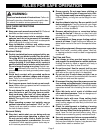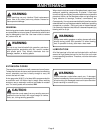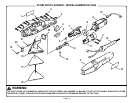
Page 3
Service
■ Tool service must be performed only by quali-
fied repair personnel. Service or maintenance
performed by unqualified personnel could result in
a risk of injury.
■ When servicing a tool, use only identical re-
placement parts. Follow instructions in Mainte-
nance section of this manual. Use of unautho-
rized parts or failure to follow Maintenance Instruc-
tions may create a risk of electric shock or injury.
Specific Safety Rules for Sanders
■ Hold tool by insulated gripping surfaces when
performing an operation where the tool may
contact hidden wiring or its own cord. Contact
with a “live” wire will make exposed metal parts of
the tool “live” and shock the operator.
■ Never use this or any power sander for wet
sanding or liquid polishing. Failure to comply can
result in electrical shock causing serious injury or
worse.
■ Keep hands away from sanding area.
Additional Rules for Safe Operation
■ Know your power tool. Read operator's manual
carefully. Learn its applications and limitations as
well as the specific potential hazards related to this
tool.
■ Always wear safety glasses. Everyday eyeglasses
have only impact-resistant lenses; they are NOT
safety glasses.
■ Protect your lungs. Wear a face or dust mask if the
operation is dusty.
■ Protect your hearing. Wear hearing protection
during extended periods of operation.
■ Don't abuse cord. Never carry tool by cord or yank
it to disconnect from receptacle. Keep cord from
heat, oil and sharp edges.
■ Make sure your extension cord is in good con-
dition. When using an extension cord, be sure to
use one heavy enough to carry the current your
product will draw. An undersized cord will cause a
drop in line voltage resulting in loss of power and
overheating. A wire gage size (A.W.G.) of at least
16 is recommended for an extension cord 100 feet
or less in length. A cord exceeding 100 feet is not
recommended. If in doubt, use the next heavier
gage. The smaller the gage number, the heavier the
cord.
RULES FOR SAFE OPERATION
■ Inspect tool cords periodically and if damaged,
have repaired at your nearest authorized service
center. Stay constantly aware of cord location.
■ Check damaged parts. Before further use of the
tool, a guard or other part that is damaged should
be carefully checked to determine that it will oper-
ate properly and perform its intended function.
Check for alignment of moving parts, binding of
moving parts, breakage of parts, mounting, and any
other conditions that may affect its operation. A
guard or other part that is damaged should be
properly repaired or replaced by an authorized
service center.
■ Inspect for and remove all nails from lumber before
sanding.
■ Drugs, Alcohol, Medication. Do not operate tool
while under the influence of drugs, alcohol, or any
medication.
■ Save these instructions. Refer to them frequently
and use them to instruct others who may use this
tool. If you loan someone this tool, loan them these
instructions also.
SAVE THESE INSTRUCTIONS
WARNING:
Some dust created by power sanding, sawing, grinding,
drilling, and other construction activities contains
chemicals known to cause cancer, birth defects or
other reproductive harm. Some examples of these
chemicals are:
• lead from lead-based paints,
• crystalline silica from bricks and cement and other
masonry products, and
• arsenic and chromium from chemically-treated
lumber.
Your risk from these exposures varies, depending on
how often you do this type of work. To reduce your
exposure to these chemicals: work in a well ventilated
area, and work with approved safety equipment, such
as those dust masks that are specially designed to filter
out microscopic particles.














